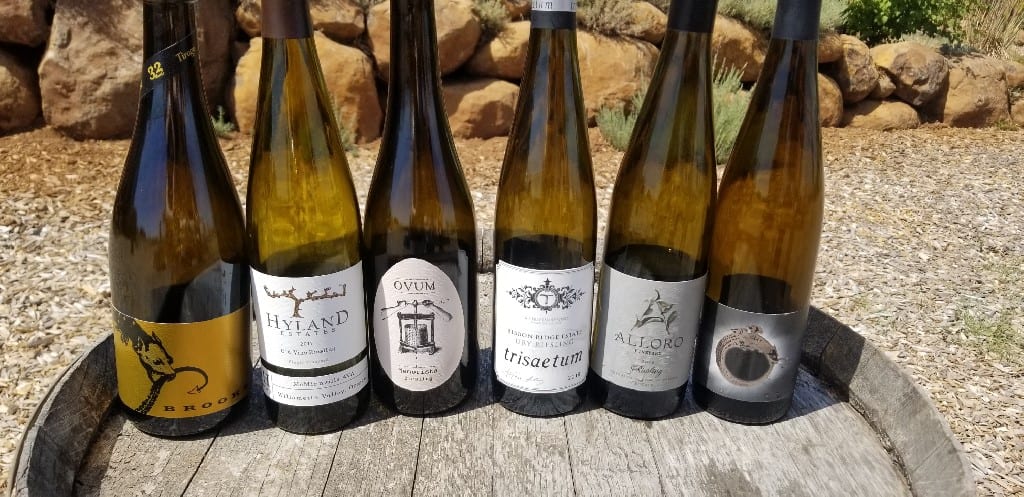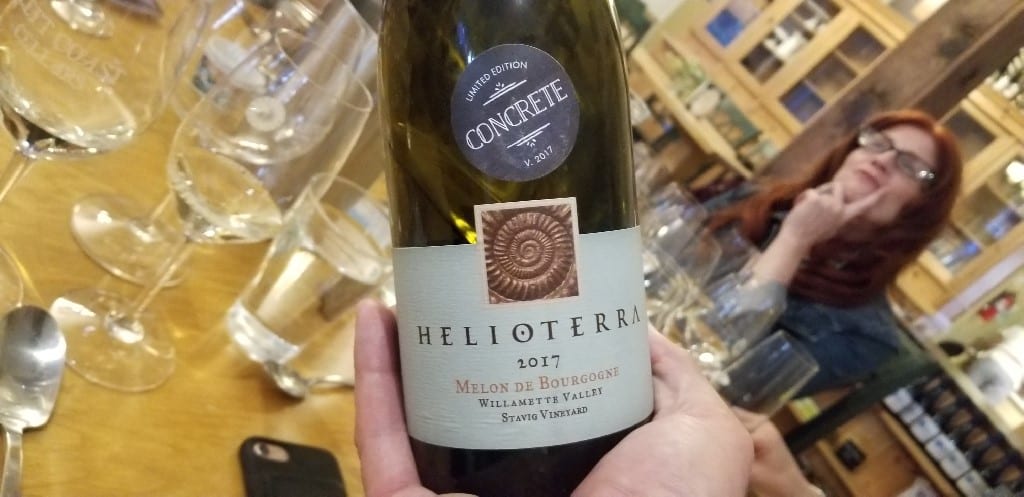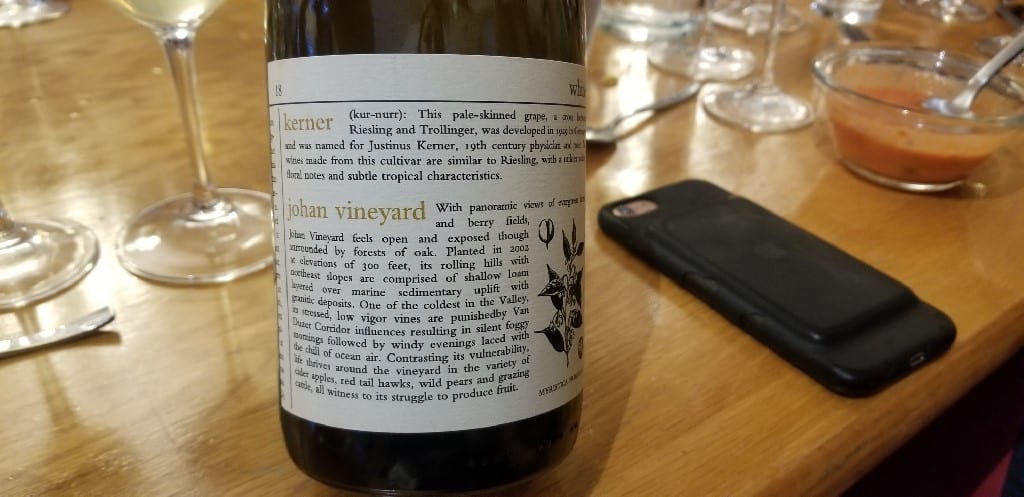
29 Oct Willamette Valley’s other varietals
Of course when you think about the Willamette Valley in Oregon, you likely think of it as a land of Pinot Noir. Pinot Noir definitely reigns in the region and as a likely partner, Chardonnay is also planted and well-regarded in the Willamette Valley. But, the Willamette Valley is far more diverse than you might think it is and there are a number of producers who are working with other grape varieties and these grapes are well-suited to the region. I explored some of these grapes in my column in the Napa Valley Register, which you can read here.
Say ‘Napa’ and people think Cabernet Sauvignon. Say ‘Burgundy’ and people think Pinot Noir and Chardonnay. Say ‘Piedmont’ and people think Nebbiolo. Say ‘Oregon’ and people think Pinot Noir.
It is easy to think of the Willamette Valley in Oregon as one large Pinot Noir-producing region. After all, of the 24,436 acres* of vineyards, 16,536 acres* are planted to Pinot Noir. At the same time Pinot Noir was planted in the 1970s, Chardonnay was also planted. The Willamette Valley shares the same latitude as Burgundy, so it makes sense that if Pinot Noir is suited for the Willamette Valley, so is Chardonnay. However, there are only 1,941 acres* planted to Chardonnay.
Pinot Gris
Second to Pinot Noir, Pinot Gris is actually the most planted grape in the Willamette Valley with 4,104 acres* of vines. When David Lett first planted Pinot Noir vines in the Willamette Valley, he also planted Chardonnay and Pinot Gris. In fact, David Lett established the West Coast’s first commercial planting of the grape in 1965.
King Estate in the southern part of the Willamette Valley is considered the king of Pinot Gris as they are the largest domestic producer with more than 50,000 cases per year.
Today there are more than 100 wineries producing Pinot Gris, including Sokol Blosser, The Eyrie Vineyard, Adelsheim Vineyard, Ponzi Vineyard, Lange Estate, Four Graces and Proteus Wines.
Pinot Gris is a wonderfully food-friendly wine, and Oregon Pinot Gris tends to be medium-bodied with aromas of apple, pear and melon with crisp acidity. It has the crispness of Italian Pinot Grigio and the weight and minerality of Alsatian Pinot Gris to produce a delightful wine that is light but serious.
Another grape that can be found in the Willamette Valley is Riesling. Riesling needs a cool viticulture climate and time to hang in the vineyard, and the Willamette Valley with its cool climate and long summer days with more than 15 hours of daylight enable the grapes to achieve full ripeness. There is a total of 282 acres* planted to Riesling in the Willamette Valley.
While the percentage of production was higher 30 years ago, today there are a more than a handful of producers who have taken the mantle for this grape that speaks to place. One of these wineries is Brooks Wine who produces 26 different Rieslings from different sites in the Willamette Valley, including their five biodynamically farmed acres planted in 1975 in Eola-Amity AVA.
Trisaetum Winery produces nine different Rieslings, including one from the sedimentary soil in their Ribbon Ridge property, as well as from their Yamhill-Carlton AVA estate and Dundee Hills AVA estate. Ovum Wines, committed to the production of white wines, makes four different Rieslings that reflect time and place. Allora Vineyard produces Riesling from their Chehalem Mountains AVA vineyard. From dry to sweet, each of the Rieslings express the place that they come from and it is fair to say that Riesling belongs in the Willamette Valley.
Gamay
Of late, there has been a resurging interest in this “other” grape from Burgundy. There is approximately only 30 acres planted but some winemakers believe in Gamay’s possibility. Chef-and-sommelier-turned-winemaker Ian Burrows tasted enough Gamay when working in restaurants to know what he wanted to make. His label Aerea Vintners produces a Gamay from the Twelve Oaks Vineyard in Yamill-Carlton AVA. Only 4.1 acres are planted to Gamay vines, which are 10 years old and located at a 350-foot elevation with laurelwood soils.
Doug Tunnell, proprietor and winemaker of Brickhouse, has a 40-acre biodynamic estate in the Ribbon Ridge AVA. Doug had lived in France and would visit Beaujolais. When he moved back to the Willamette Valley, he was reminded of Beaujolais and decided to plant Gamay in 1992.
Methven Vineyards in the Eola-Amity Hills AVA planted six acres of Gamay in 2000 and produce Gamay and Gamay Rosé.
Vincent Fritzsche, proprietor and winemaker at Vincent Wine Company moved from California to Oregon in 2000 because he said he thinks Oregon is one of the most exciting places to make wine. And, due to the soils and climate, he said he believes that Willamette Valley is becoming the place to grow Gamay. Vincent started making Gamay in 2015 and sources fruit from the Bjornson Vineyard in the Eola-Amity Hills AVA, as does John Grochau who also makes Gamay from that vineyard.
After tasting these mouth-watering wines with beautiful fruit and floral aromas and high acidity, I hope to see more Gamay from the Willamette Valley.
Pinot Gris, Riesling and Gamay have champions in the Willamette Valley who want to see these grapes get more recognition. Yet there are even more varieties growing in the Willamette Valley and many young winemakers are getting behind them.
Winemaker Joe Wright at Left Coast Wines is producing a Brut Rosé of Pinot Meunier from estate fruit as well as Syrah from .5 acres from the highest elevation on their property.
Winemaker Anne Hubatch started Helioterra Wines in 2009 and in addition to Pinot Noir, makes more experimental varieties such as an Arneis from the Redman Vineyard in the Ribbon Ridge AVA and a Melon de Bourgogne from a cool pocket in the Willamette Valley called Happy Valley.
Winemaker Laura Cusick of Craft Wine is sourcing fruit from across the state and is making Kerner sourced from fewer than five rows growing in the Van Duzer Corridor and Cabernet Franc from the Eola-Amity Hills AVA.
Chris James is the winemaker and proprietor of Chris James Cellars and in 2013 he planted his 17-acre vineyard with Lagrien, Dolcetto, Scheurebe, Sauvignon Blanc, Gewurztraminer, Gamay, Muller Thurgau and Riesling, as well as Pinot Noir and Chardonnay.
Rachel Rose, the winemaker at Bryn Mawr in the Eola-Amity Hills AVA, planted Dolcetto, which due to the growing degree days, elevation, exposure and rock soils is well-suited to the area and can ripen well. She also planted Tempranillo, which is not as suited to the climate but sees promise with the grapes’ potential.
The Willamette Valley is a phenomenal growing region that can grow lots of grape varieties due to its micro-climates. Pinot Noir still reigns as king in the Willamette Valley, but there is a trend towards alternative grape varieties that are worth looking out for.
*vineyard acreage sourced from Willamette Valley Wines
Read the original story in the Napa Valley Register.
Discover more from Please The Palate
Subscribe to get the latest posts sent to your email.











